Top News

Allscripts shares closed Thursday at $9.14, down over 14 percent since Wednesday’s after-hours announcement that it would not pursue being acquired and instead will replace its executives and forge ahead. The company’s market cap is $1.6 billion. If you had invested $10,000 each in Allscripts and Cerner shares on January 1, 2000, you’d have $1,983 and $157,874, respectively. If you’d made the same investment five years ago, you would be holding $4,560 and $27,982. Obviously the company is hoping that Paul Black had enough influence in Cerner’s success to be able to replicate it at Allscripts. They’re bragging publicly on his background and Cerner’s success, which is odd given that Cerner is perhaps its most direct competitor.
Reader Comments
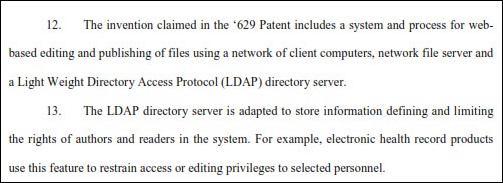
From HITEsq: “Re: another patent troll. A Puerto Rico-based company, Ingeniador, is going after GE Healthcare and McKesson for violating a 2006 patent whose claims are as ridiculous as its title – ‘Publishing System for Intranet.’”” I did some digging and found that the “company” is a former Hewlett-Packard software engineer named Marcos Polanco, who developed a database management system for his employer and then sued them for royalties. Since then, he has sued everybody and their brother, including Microsoft, HP, Oracle, Lexmark, and SAP. He apparently bought the patent he’s waving around from an oil services company. He’s big on Puerto Rican enterprise, entrepreneurship, serving as COO of glucometer vendor iCare Medical, and filing ludicrous lawsuits.

From Top Chef: “Re: Paul Black. I knew him from his Cerner days. Good guy, very smart and affable. Guess he’s ready to jump into it again!” Glen and his loyalists had to be fired, of course, when the PE tire kickers passed on Allscripts, leaving the company desperate to change something (anything) to put the stench of a disastrous year behind it — missing Wall Street expectations; firing the Eclipsys supporters on its board and barely keeping Glen; caving in to a proxy fight by reluctantly adding three HealthCor-nominated board members; watching its share price drop nearly 40 percent in a single day; having word of its private equity courtship leaked publicly; choosing the worst possible time to announce the halt in MyWay development; and having its customers name it as the worst vendor in the country with their KLAS product ratings. Not to mention the final embarrassment of having the potential acquirers walk away from the smoking wreckage. Paul Black has his work cut out for him. I would like to see his first order of business be to drop the company’s ridiculous lawsuit against NYCHHC and provide an update on the Sunrise integration status, which was supposed to have gone to beta in June per Glen. I’m not convinced Sunrise is viable given lack of sales and what must be high R&D costs and a declining user base, so they need a strategy that doesn’t involve going toe-to-toe with Epic and also to re-introduce Sunrise Financial Manager, which got lost in all the juicy company turmoil. The PE guys would have trimmed the product line and headcount (7,000 employees seems like a lot), so with Glen out of the picture, those options are surely on the table. Unfortunately, they’ll have to make those decisions under Wall Street’s microscope and that’s hard. Here’s where you get the chance to play Monday morning quarterback like me: leave a comment with the 2-3 things that Paul Black needs to do first to get Allscripts on track.
HIStalk Announcements and Requests

 I got my first Christmas present in the mail yesterday from a couple of my favorite gal pals: a daily shoe calendar for 2013. Each day looks better than the next!
I got my first Christmas present in the mail yesterday from a couple of my favorite gal pals: a daily shoe calendar for 2013. Each day looks better than the next!

 Mr. H also gave me an early Christmas present with the refresh of the HIStalk Practice site, complete with a new logo (thank you, Dodge Communications) and a sleeker format. Take a peek and let us know what you think. This week’s HIStalk Practice highlights include a don’t miss year-in-review post by Joel Diamond, which I promise is the funniest read of the season. SRS’s EHR takes the top spot in a survey of ambulatory care specialists. The big winners and losers in KLAS’s Physician Practice Solutions categories. KLAS is criticized for favoring big vendors that subsidize KLAS operations. CareCloud names John J. Walsh CTO. Thanks for reading.
Mr. H also gave me an early Christmas present with the refresh of the HIStalk Practice site, complete with a new logo (thank you, Dodge Communications) and a sleeker format. Take a peek and let us know what you think. This week’s HIStalk Practice highlights include a don’t miss year-in-review post by Joel Diamond, which I promise is the funniest read of the season. SRS’s EHR takes the top spot in a survey of ambulatory care specialists. The big winners and losers in KLAS’s Physician Practice Solutions categories. KLAS is criticized for favoring big vendors that subsidize KLAS operations. CareCloud names John J. Walsh CTO. Thanks for reading.
On the Jobs Board: Chief Information Officer, Cerner Experienced Providers.
If the world ends today or if I decide that nobody will be reading on Christmas Eve, there won’t be a Monday Morning Update. I’m betting I’ll be right here over the weekend, though.
Acquisitions, Funding, Business, and Stock
Allscripts held a short investor conference call Thursday morning to go over the changes. You can listen to the recording here. My notes:
- The company still won’t say whether it received any acquisition offers, only that it decided to continue as the current entity.
- The CFO is aggressively looking at cost controls and productivity plans.
- Black: “We’re not going to waste any time going to work.”
- ICD-10 functionality is complete and Meaningful Use 2 is well underway.
- “Disruptive, open technology,” common user experience, and single patient workflow.
- “There will be no substitute for results” and “we need to move quickly.”
- Question: who will lead the product refresh effort? Answer: Cliff Meltzer, who will continue as EVP of solutions development.
- Question: since the company stopped giving guidance, how’s the quarter going? Answer: we’ll benefit from the clarity around the company’s direction. The lack of clarity this year was a misstep.
- Question: was the board’s decision to stay independent unanimous? Answer: the board doesn’t comment on their deliberations. There were no dissents on Glen stepping down.
- Question: is customer attrition running in line historically? Answer: I don’t have the number, but retention is steady in all facets of the business.
- Question: Glen said earlier this year that the company brought on 400 employees to work on integration. Was it money well spent and are customers happy with functionality? Answer: Not all of our clients are happy and we won’t rest until 100 percent are. I won’t be happy until we don’t need a sales force because they’re beating down our doors and our fax machines are burning up with orders. R&D spend will continue at the current level.
- Question: what’s the order of strategic initiatives? Answer: solidify the client base; review expenses; step up revenue, engineering, and operations to keep surprises to a minimum.
- Question: was there a precipitating event that led to the changes? Answer: just the completion of the strategic review.
- Question: what areas other than product innovation and R&D will be emphasized? Answer: increase emphasis on application hosting, add managed services for the large ambulatory clients, review why home health and patient flow solutions don’t seem to produce as well as the market would suggest is possible.
- Question: how will the executive suite shape up? Answer: I expect to bring folks in, but review talent and promote from within if possible. I will bring in people I’m comfortable with working with and those I’ve worked with in the past.
- Question: what’s the lowest-hanging fruit? Answer: the large number of doctors using the systems regularly are the mother lode and the company will build around that core.
Terms of Paul Black’s deal to take over Allscripts include a three-year contract for $1 million per year in salary and a $1.5 million annual bonus target with the 2013 payout guaranteed; a $1.25 million signing bonus; $3 million in shares vesting over three years; $3 million in incentive-based shares; $2.5 million in service-based restricted shares vesting over four years; and $2.5 million in a performance-based equity award. If he quits or is fired, he gets two years’ of severance including his bonus target (total of $5 million) and an extra year of vesting. Glen Tullman and Lee Shapiro get a parting gift that includes a year’s salary, their target bonuses, and acceleration of vesting. If the company sells itself within a year, they’ll get two years’ salary plus their target bonus.
Sales

HealthEast’s (MN) board of directors approves the $135 million purchase of Epic, which will replace seven platforms.
The US Navy and Army award Dell, BRIT Systems, and Acuo Technologies a $45 million contract to create a Unified Clinical Archive for PACS to be used by 49 medical facilities.
Meadowlands Hospital Medical Center (NJ) and Urban Health Plan (NY) choose eClinicalWorks Care Coordination Medical Record and EHR solutions to advance their ACO initiatives.
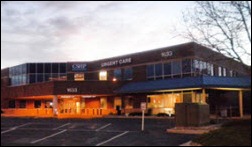
Colorado Springs Health Partners will implement the Professional Charge Capture solution from MedAptus for inpatient professional services coding and billing.
Hometown Health (NV) will deploy MedHOK’s care management, quality, and compliance platform.
SAIC wins a one-year, $17 million contract to support the Coast Guard’s Integrated Health Information System, which is the name of its implementation of Epic.
People
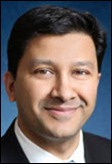
Harris Corp. names Vishal Agrawal, MD (McKinsey and Co.) president of Harris Healthcare Solutions.
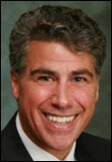
Bob Hajek (Humanscale) joins Divurgent as a VP of client services.
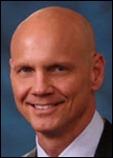
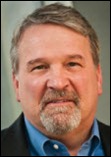

PatientSafe Solutions names Frank Pecaitis (GE Healthcare) SVP of sales and Bruce Eklund (AHM) SVP of operations, also promoting Joseph Condurso from president/COO to president/CEO.
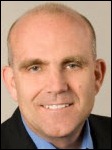
Tom Bang (A-Life Medical, Cardinal Health) is named CEO of post-acute care systems vendor BlueStep Systems. Former CEO Roy Rasband will move to the CTO role.
Announcements and Implementations
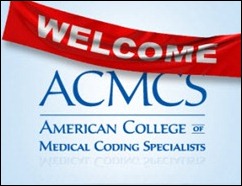
The 500-member American College of Medical Coding Specialists votes to join AHIMA.
The Texas Organization of Rural & Community Hospitals announces the Phase 1 go-live of its TORCH HIE at Wilbarger General Hospital (TX). It uses the CollaborNet interoperability solution from Holon Solutions.
Government and Politics
HHS’s Office of Inspect General advises hospitals that they are not violating anti-kickback statutes when they provide community physician practices a free interface to support exchanging orders and results.
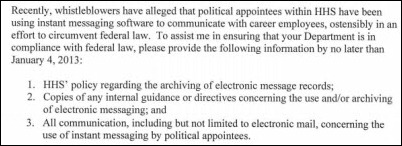
Charles Boustany, Jr. MD (R-LA), chair of House Subcommittee on Oversight, sends a letter to HHS Secretary Kathleen Sebelius asking her to provide the department’s policies on archiving electronic messaging. Whistleblowers have alleged that HHS’s political appointees are intentionally using instant messaging to avoid leaving a discoverable record of their communication with department employees.
The government’s Space and Naval Warfare Systems Center, charged with developing a Department of Defense database for tracking medical examinations for officer candidates, is found to be $7 million over budget and may never deliver a working system. Administration of the contract, which was issued an Alaska firm under a government requirement that Alaska native companies receive preferential treatment, has been taken over by the General Services administration.
Innovation and Research
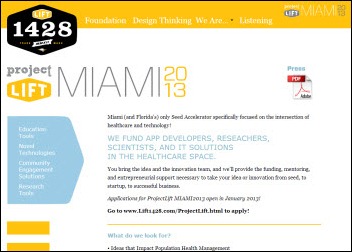
Yet another healthcare IT accelerator fans to life, this time in Miami. Project Lift Miami will offer 10 to 15 startups seed funding, office space, and mentoring in a 100-day program.
Microsoft is working with the military to offer Kinect-powered home physical therapy treatments to injured soldiers and veterans using the ReMotion 360 software from InfoStrat. Microsoft is also working on a Kinect-based based system for conducting online group therapy sessions for patients with post-traumatic stress disorder.
Technology
The Wilmington, DE VA hospital rolls out a visitor way-finding kiosk system that features a talking avatar named Val, which stands for “Veterans Affairs locator.” The system, which also allows visitors to pre-plan their visit online, was developed by LogicJunction.

A public radio station profiles Syracuse-based startup Simple Admit, which allows patients to complete their forms online before their provider visit.
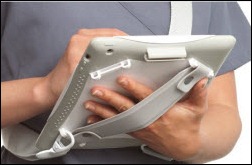
Griffin Technology offers the AirStrap Med, a $90 sling case that makes it easier to use an iPad during rounds.
Other
A poll
finds that only a third of health system leaders are confident in their organization’s readiness for Meaningful Use Stage 2.
An interesting vision of how clinical documentation could be performed by the rounding teams of academic medical centers, offered by by John Halamka on his blog:
The entire care team jointly authors a daily note for each patient using a novel application inspired by Wikipedia editing and Facebook communication. Data is captured using disease-specific templates to ensure appropriate quality indicators are recorded. At the end of each day, the primary physician responsible for the patient’s care signs the note on behalf of the care team and the note is locked. Gone are the "chart wars", redundant statements, and miscommunication among team members. As the note is signed, key concepts described in the note are codified in SNOMED-CT. The SNOMED-CT concepts are reduced to a selection of suggested ICD-10 billing codes. A rules engine reports back to the clinician where additional detail is needed to justify each ICD-10 code i.e. a fracture must have the specifics of right/left, distal/proximal, open/closed, simple/comminuted. You can imagine that the moving parts I’ve described are modular components provided by different companies via cloud hosted web services (similar to the decision support service provider idea).
Medical device manufacturers are blaming the Affordable Care Act’s 2.3 percent tax on their products for industry layoffs, but economists say companies were already bloated in a slow market and would have had to cut jobs anyway. The manufacturers‘ trade group is trying to have repeal of the tax included in fiscal cliff negotiations, but the President says he’s not a fan of that idea.

Pediatric patients at Geisinger Medical Center (PA) receive iPad-based visits from Santa Claus in the hospital’s “Santa Cam” program.
Weird News Andy summarizes this story as “Good news, bad news.” A 27-year-old cystic fibrosis patient receives a long-awaited lung transplant, but then dies of lung cancer 16 months later. The lungs she received were from a donor who smoked heavily, which is apparently the case in 40 percent of lung transplants. The hospital trust has apologized for not disclosing that fact in their explanation of the risks involved, saying that patients almost always want whatever lungs they can get.
Sponsor Updates

- Sunquest hosted a December 7 fundraiser to provide foster children with Christmas gifts. The cookout, Hostess Twinkie raffle, and company donation raised over $7,000 for Aviva Children’s Services.

- CTG Health Solutions launched its Holiday Military Appreciation Campaign for military family members of its employees, sending gift packages both to those serving and to their families. The company also continued its tradition of taking the money that would have been spent on customer greeting cards and instead donating it to Operation Homefront, which provides support to military families.
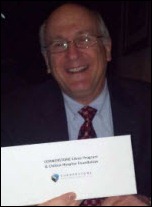
- Cornerstone Advisors establishes Cornerstone CAres, a charitable giving program funded by employee contributions and matching company donations. Its first project was to help employees of long-time client Chilton Hospital (NJ), which was severely impacted by Hurricane Sandy. Receiving the donation was Chilton VP/CIO Mark Lederman (above).
- SIS employees raised over $12,000 to purchase gifts and supplies in support of Embracing Arms home for girls, The Empty Stocking Fund, the Secret Santa Ministry, and Toys for Tots.
- Liaison Technologies shares its 2013 forecast for cloud adoption, business integration, and managed services.
- Levi, Ray and Shoup offers a white paper on enhanced document printing and viewing in the healthcare industry.
- A White Plume blog post called “Healthcare’s Wake-Up Call for 2013-2014” warns of the urgency needed to prepare for PQRS, MU2, ICD-10, and HIX.
- Fulcrum Methods provides details of how it helped NorthBay Healthcare successfully attest for Meaningful Use.
- Raymond Fabius, MD, chief medical officer of Truven Health Analytics, warns employers that moving to an exchange-only health benefits model based on cost alone.
- Business NH Magazine names Bottomline Technologies a “Best Company to Work For” for the fifth consecutive year.
- Northwest Michigan Surgery Center shares how its implementation of Versus Advantages IR/RFIF RTLS has helped it perform as one of the nation’s top ambulatory surgery centers.
- Medseek will incorporate the Healthwise Patient Engagement solution into its health content offerings.
- InteliChart and RelayHealth develop a health information exchange platform that integrates with InteliChart’s suite of connectivity solutions and provides bi-directional exchange between the ambulatory and hospital settings.
- Humedica and Pfizer announce a multi-year strategic alliance to use Humedica’s de-identified healthcare data to improve drug effectiveness.
- EMRConsultant offers a free survey for practices interested in improving efficiency and reducing expenses.
- Modern Healthcare names MedAssets as the largest revenue cycle company.
EPtalk by Dr. Jayne
CCHIT will develop an IT framework for Accountable Care Organizations, hoping to identify the infrastructure needed. An advisory panel is being formed to develop the framework, which will ultimately lead to additional CCHIT certification programs.
ONC seeks applications for two new consumer-focused HIT FACA Workgroups: the HIT Policy Committee’s Consumer Empowerment Workgroup and the HIT Standards Committee’s Consumer Technology Workgroup. Applications are due by January 14, 2013.
As if this week’s predicted apocalypse isn’t enough, a recent article cites ICD-10 as causing shock, awe, and fear. Seriously, people, we’ve known it’s been coming for years, and warning of “apocalyptic-type scenarios” is a little much. Remember Y2K? A staffer at UnitedHealth Group is quoted as saying that use of both ICD-9 and ICD-10 together will cause “mass hysteria.” Guess what? Using both will be reality for many of us, because not all payers are switching over. There’s no requirement for non-covered entities or those using paper claims to change.

I received a fair amount of feedback on my recent discussion of the Meaningful Use smoking status measure.
From Under the Mistletoe: “Dr. Jayne, you are not a hair splitter at all, and I think these descriptors are absurd. This is the calculation we always use: pack years. Certainly closer to quantifiable, not perfect, but I am really disappointed in what you described from SNOMED. How disappointed was I? Well, I could say ‘extremely,’ or would you prefer on a 1 to 10 scale with 10 as the worst possible – a 10?”
Mr. H hinted to one correspondent that I may have been “cranky” when I wrote that piece, which I guess is true. Like a reported 77 percent of physicians, I’m at least somewhat pessimistic about the future of medicine and exhibit a higher degree of pessimism after a day of seeing patients. When you’re dealing with parents who can’t figure out how to pay for a $4 antibiotic for their child (and who bring her to the ER because they don’t have Tylenol at home), some of the things we do in the informatics office seem pretty ludicrous.


HIMSS created a word cloud showing the educational offerings for the upcoming HIMSS13 meeting in New Orleans. In response, I offer up my own.

Contacts
Mr. H, Inga, Dr. Jayne, Dr. Gregg.
More news: HIStalk Practice, HIStalk Connect.




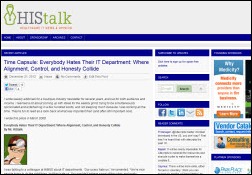

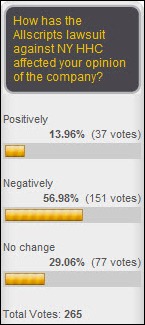

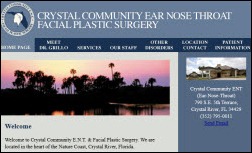
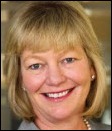


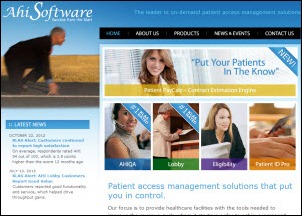

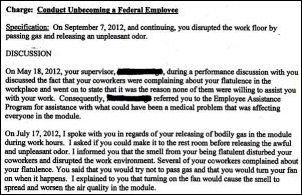





























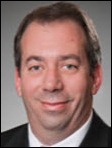
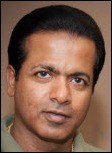

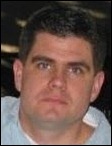
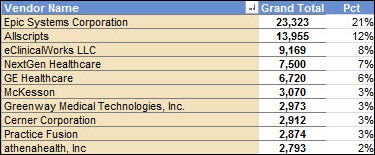


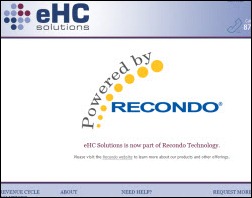


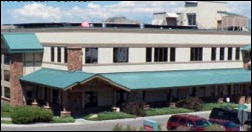
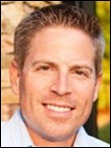
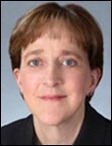


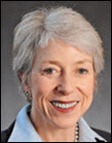
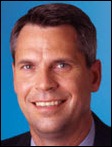

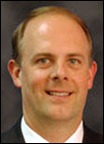

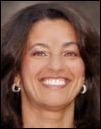
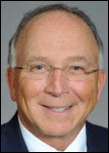
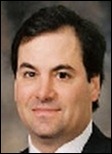
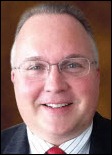

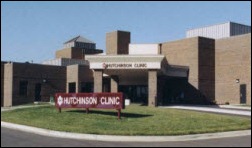
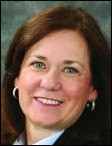





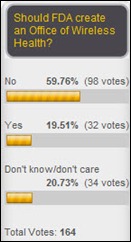

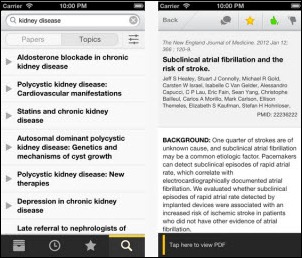
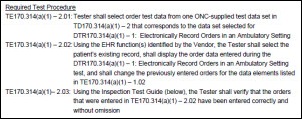

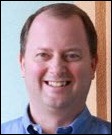
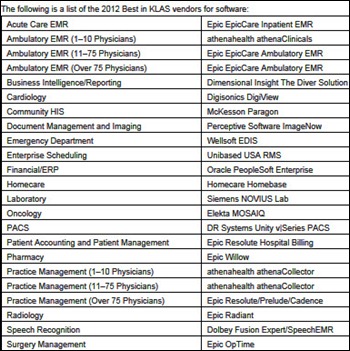

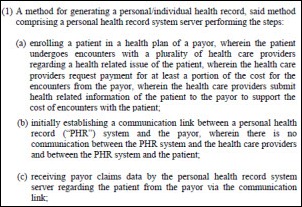

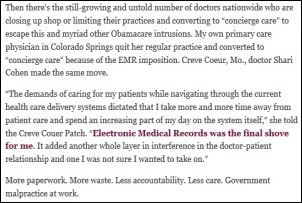
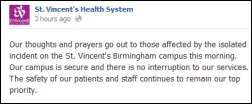
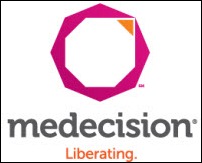

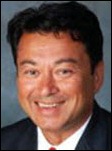
That, or we see if Judy will announce Epic's new Aviation module (probably called Kitty Hawk) that has integrated Cruise…